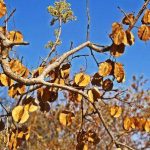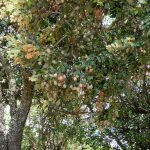TREE LIFE
OCTOBER 1989
MASHONALAND CALENDAR
Tuesday 3rd October: Botanic Garden Walk. (Flowering time again). Meet at the Herbarium at 1644 for 1700 hours. For security reasons from now on, those attending the walks are advised to park their cars in the car park beside the Herbarium.
Sunday 15th October: The outing this month is to the Marondera area, to Mr and Mrs. A. Rutherford’s farm – Igava. In the morning we will ‘snouze’ and fossick over a small rocky outcrop in the woodland. After lunch Mr. Rutherford will have available, a tractor and trailer on which to transport us around his game park. We are sure members will enjoy this novelty, particularly in view of the expected October heat.
Bus will be leaving the Monomatapa car park at 0830 hours and the fare will be $24. Please phone Joy Killian on 308398 before Thursday 12th October to reserve your seat.
Saturday 28th October: Mukuvisi Woodlands Walk. Meet at the Paget Road/Inyanga Crescent gate at 1500 hours.
MATABELELAND CALENDAR
On Sunday October 1st we go to Falcon College, Esigodini, to their quiet Waters Conservation Area. Meet at 0830 hours at the Hotel Rio where cars, we hope, may be left safely.
On Sunday November 5th we hope to go to Roy Stephens’ plot near the Matopos Mission, via the Old Gwanda Road.
MATABELELAND NOTES
On Sunday 3rd September we went 30km up the Airport road to Kenmap Farm, Mr. Guy Acutt.
Some of the soils were quite loamy, and some lighter Kalahari sand, so that predominant trees varied a bit.
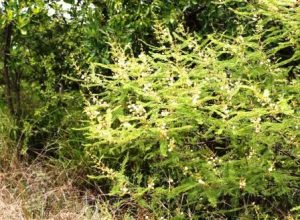
Acacia arenaria. Photo: Bart Wursten. Source: Flora of Zimbabwe
Although it was warm and pretty dry with not much leaf to be seen, we had a most interesting morning identifying some 30 species, including no fewer than 9 different Acacias, some of which we don’t often see, this lead to some confusion at first! In particular, we saw, Acacia arenaria, A. fleckii, A. mellifera and A. polyacantha. We also saw A. gerrardii, A. karroo, A. nigrescens, very knobby, and very many A. nilotica, many A. rehmanniana. Also Azanza garckeana, Bauhinia galpinii, Bolusanthus speciosus, Cassine transvaalensis, Colophospermum mopane, with quite a few biggish ones, Combretum imberbe, many including some very large specimens, Combretum molle, Dalbergia melanoxylon, Dombeya rotundifolia, still flowering, Euclea divinorum, Kirkia acuminata, Rhus lancea small but widespread, Strychnos spinosa, Tarchonanthus camphoratus.
Although species were not many, as seems to be usual on Kalahari sand, many were interesting, and it was a good morning, enlivened by some good talks, Albert Lehuray gave an excellent and comprehensive talk on Colophospermum mopane, followed by Thora Hartley on Acacia goetzei, which we did not actually see, and Acacia mellifera, which we did. Then Ken Blake talked well on eucleas and on Combretum imberbe. All these excellent talks added much to the morning.
-C. Sykes.
BOTANIC GARDEN WALK, SEPTEMBER 1989
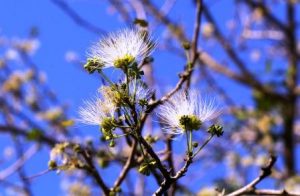
Albizia anthelmintica. Photo: Bart Wursten. Source: Flora of Zimbabwe
This month we decided to look around at the various trees and see what they were doing in September and we were greatly rewarded. The Albizia anthelmintica was covered in white shaving brush flowers. The folk from the lowveld natural history society (no Wildlife Society) once told us how these were the first herald of spring. Many of us may remember being driven around Mr Sparrow’s farm surrounded by numerous A. anthelmintica in bloom. Playhelminths are tapeworms so anti-helminth indicates it rids one of tapeworm – a traditional cure that is apparently effective.
From there we rushed down towards the pond lest we miss the golden rays of the setting sun catching the large maroon to yellow blooms on Fernandoa magnifica. We seem to admire these trees every September so I was pleased that we had a number of members to whom this was their first introduction. These trees flower without any leaves and bear prolifically. The flowers are enormous (15cm across) and showy. They belong to the BIGNONIACEAE and, as with Kigelia, are pollinated by bats. From there on the logic is fairly simple. If a tree is pollinated by an insect, eg a bee, the ‘reward’ for pollination is insect sized – a small amount of nectar or pollen. But when a flower is pollinated by a warm-blooded mammal like a bat, then this mammal needs a greater reward because its running costs are very expensive. Incidentally using the term warm-blooded has gone out of vogue now. Bats in particular often allow their temperatures to drop considerably while hibernating; they then ‘reheat’ themselves as they end their period of torpor. So warm-blooded is not appropriate for an animal that is sometimes cold. In addition ‘cold-blooded’ lizards and snakes can heat their blood in the sun. So we replace these two terms with four impressively long words : an animal is either endothermic (inside temperature) and heats the body from within (e.g. bats, birds and us) or ectothermic (outside temperature) and heats up in the sun or by lying next to a warm rock. In addition, an animal is either homeothermic (same temperature) and controls the temperature (like us) or is poikilothermic (changing temperature) in which case the temperature fluctuates (like snakes, frogs, and bats). So I should have said Fernandoa is pollinated by a poikilothermic endotherm that needs to get an energy-rich reward. This reward comes in the form of a thick sugar-rich nectar that tastes like honey and molasses. Each bloom may contain a teaspoon of nectar or more. We then set about becoming nectar thieves and lapped up the sweet nectar from inside these soft petals, a very sensuous experience.
Just alongside the Fernandoa we admired the grove of fever trees (Acacia xanthophloea). These ghostly luminous yellow trunks with the odd blackened dead branch (which Tom usually has removed in the Gardens) are best appreciated by full moonlight. They grow in enormous groves along the Save river. Acres of fever trees alone on the flat low low-lying river terrace with knee-high grass. It was here in Easter 1982 that I first heard the low booming sound of Ground Hornbills echoing through the stillness. Maureen is convinced we need to organize another moonlight expedition.
The Faidherbia albida were in full leaf, although they flowered there was no sign of any fruit this year. After a short detour to eat fruit in the commercial section of the Botanic Gardens we set off to see Trichocladus ellipticus in full flower. This flower is important as it represents an insect-pollinated flower in a large group of plants that is wind-pollinated. These trees include many of the deciduous trees of Europe and America, oaks, elms, beech etc.
We concluded the walk by examining those SAPOTACEAE that we had had trouble with on Murahwa’s Hill, Mutare. We saw that Chrysophyllum gorungosanum has a brown bloom on the under surface of the leaf where as the very similar Bequaertiodendron natalense is silver. The leaves we saw in Mutare were definitely silver. So that solves another puzzle.
Well, that was but an introduction to flowers – October is the real month for flowers.
-Kim ST.J. Damstra
THE MIDDLE CATCHMENT OF THE NYARUPINDA
This botanical paradise is shown on the Mtorashanga and Raffingora map sheets of the 1:50 000 series. The area is part of Chepstow of Gomo (homestead Grid Reference is TS351 058) and Nyarapinda Extension (the latter is mentioned on page 50 in the S.R. Geological Survey Bulletin No. 49).
The Middle Nyarupinda has been chosen for several reasons.
- My home is part of it
- The river system flows through granite sands quartz gravel and doleritic clay, these soil types indicate the level of water available to the flora
- There are many vlei margins which support species of plants suited to them.
- Unspoilt anthills both active and quiescent are plentiful
- In 1978, when a large earth dam filled, many anthills became riverine and more water became available from time to time.
- Something like a microclimate has developed in a few places where trees grow at the confluence of narrow gorges. This situation is favoured by shade-loving vegetation.
- Slopes that are stony and exposed to the elements are the home of plant life adapted to very dry conditions, for example Olax dissitiflora. In 1983 a search was made for the unusual on a ridge of quartz in the middle of an arable land. The rewards were Ochna gambleoides and Vernonia glaberrima. Also of interest were huge old Muwonga (Pericopsis angolensis) stumps, an iron smelting site (and separate living site) and three prospecting pits. On this occasion, someone remarked when we look at trees we fall into holes and when we look at holes we bump into trees.
- Perhaps there is more to be found . . . .?
Observations in this botanical paradise are ‘a humble attempt to promote a more minute inquiry into natural history’. This is a quotation from curate naturalist Rev. Gilbert White, who penned “The Natural History of Selborne” in Hampshire, England.
A few remarks about the locality so that comparisons can be made, because its altitude is lower than Harare the weather is usually warmer and drier. This year the mild winter has delayed leaf fall and the bush is still colourful with reds and orange. Of the yellow leaves those of Zanha africana were the first to fall in June.
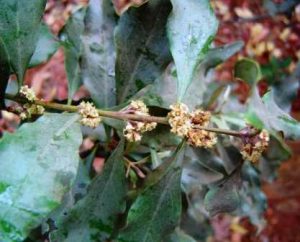
Euclea divinorum. Photo: Bart Wursten. Source: Flora of Zimbabwe
In July evergreen Euclea natalensis was in flower bud, now a month later Euclea divinorum has clusters of spice-coloured bead-like scented flowers, Turraea nilotica is leafless and in flower now. Many species flower in the winter months and are being seen for the first time because of this commitment to the Tree Life Bulletin. For example, Cadaba termitaria has been in rather solitary flower for months, its blooms look like the hands of Javanese dancers.
At the moment Dichrostachys cinerea bears dry clumps of pods and perhaps a bagworm or two – these use their hosts’ leaves for the bag. The bag is made of spines cemented together when the host is Acacia, and neatly cut ‘holes’ for the bags which hang from twiggy vegetation.
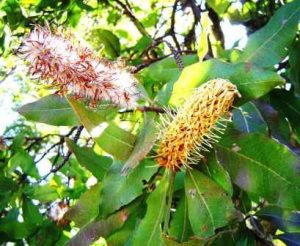
Faurea speciosa. Photo: Bart Wursten. Source: Flora of Zimbabwe
This winter Faurea speciosa has been spectacular with its red/green leaves and almost as many flower spikes as leaves. The blossoms have been taken over by honeybees. On an unoccupied tree an insect egg case was found which can only be described as resembling a very small cluster of bovine testicles. With reference to Alan Weavings ‘Insects” page 25, Figure 8 shows a similar but not identical cluster of Assasin bug egg cases.
On June 25th Acacia robusta was located near a stream on stony soil. This keyed out in a minute using the Coates Palgrave book; fortunately there were well-formed still green pods and a few grey-green leaves to help identify the species. The field impression is a misty grey-green tree, its shape is not unlike A. gerrardii but the bark and pods are different and foliage is sparse. What is robust about Acacia robusta? (Editor’s note – first prize for the first correct answer will be a weekend in a clump of A. ataxacantha).
The flowering sequence of Acacias is another topic – A. robusta may precede A. galpinii does anyone know? A list would keep us on the qui vive.
By the way, has the prickle test caught on? Some test results will appear in this Bulletin bye and bye.
In the future “Middle Nyarupinda” will be limited to one pertinent paragraph.
-Benidicta Graves
DITCHWE LEMON FOREST – 17TH SEPTEMBER 1989
“Lemon flower is very pretty, lemon flower is very sweet
But the fruit of the lemon is impossible to eat” Golden oldie – Harry Belafonte
The first line of the above was proved to be true on our outing this day – we found a Citrus Lemon flowering and, having noted the gland dots in the leaves (without which no member of the RUTACEAE family is complete) were shown the gland dots in the petals. Next time I pass Mazowe Citrus Estates I shall try to check the petals of Citrus aurantium (the orange) and see whether these glands are a common denominator in the family.
No-one would admit to suffering from scurvy and so the second line of the couplet remains unproven.
Not surprisingly we found many species flowering. Members of the Ornithological Society who joined us spent agonizing minutes trying to identify the Sunbirds that were feasting on the flowers of the very large Acacia galpinii. There were many of this species, all enormous and all covered with their very distinctive red and yellow flower spikes, a distinctive and unusual feature among species of Acacia.
Also flowering was Carissa edulis, APOCYNACEAE, and Combretum mossambicense, COMBRETACEAE, the latter producing clusters of shaving brushes over the other trees upon which it was climbing.
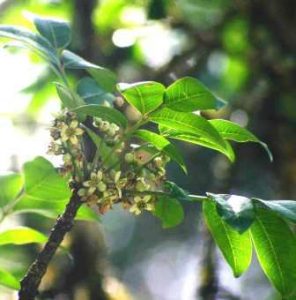
Ekebergia capensis. Photo: Bart Wursten. Source: Flora of Zimbabwe
Mention has already been made of the large size of the Acacias. The same applies to three members of the MELIACEAE family which were thriving in the forest – Ekebergia capensis with shining pointed leaflets, Trichilia emetica which most people had only seen growing along the Zambezi at Mana Pools and Khaya nyasica from around which was gathered a small harvest of seed. Also standing tall and bearing much fruit was Kigelia africana, BIGNONIACEAE, with ample evidence on the ground that the bats had been doing their stuff amongst the flowers. A smaller member of the same family, Markhamia acuminata, yielded a lot of seed from its long, lentical-spotted pods, many of which were paired from a common stalk.
Daunting banks of rambling, thorny branches caused us to stop to attempt an identification. The scattered hooked thorns along the branches led us to the alternatives of Acacia ataxacantha or A. schweinfurthii. Both have a gland at the base of the petiole, the former resembling a small green grub and the latter a dark coloured beetle. The beetles won the day.
During this discussion we learned that the rule “spike thorns, puff ball flowers, hooked thorns, spiky flowers” only applies to species with paired thorns i.e. not to the above two have scattered thorns. In fact A. ataxacantha has a spiky flower, and A. schweinfurthii has a puff ball!!
What a pleasure it was to be joined by three ladies from Karoi, members of the Aloe and Cactus Society and the Ornithological Society. We hope that they enjoyed this delightful spot as much as we did.
-D.Hicks
CHIKWENYA NOTES – AUGUST AND SPETEMBER 1989
The first ripe pods of the Acacia (Faidherbia) albida are now falling – often helped down by elephant impatiently shaking their trunks. The Combretum microphyllum is in full flower – cascades of scarlet in the canopies of the albidas, which this vine uses for support.
Everywhere there are trees flowering. The Kigelia africana have had abundant ‘candelabra’ with deep crimson trumpet blossoms, and now the first small green ‘sausages’ are beginning to show. The Trichilia emetica are covered with bunches of small starry off-white flowers, very sweetly scented in the dusk.
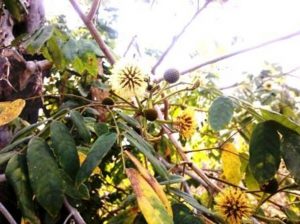
Xylia torreana. Photo: Bart Wursten. Source: Flora of Zimbabwe
The Cordyla africana have been glowing with their nectar-laden, old gold flowers, attracting flocks of long-tailed starlings in a dazzling explosion of noise and colour. The Cassia abbreviata are also a blaze of acid yellow, in vivid contrast to the charcoal black of their trunks.
The Capparis tomentosa which grows either in dense bushes or will climb into the trees given the opportunity, is flowering with its sweetly perfumed filigree blossoms. The knobby thorns, Acacia nigrescens have been covered in creamy spikes of blossom.
In the jesse, the sand ashes, Xylia torreana are full of their beautiful yellow ‘pom poms’ in breathtaking contrast to the general jesse, which looks as if it is totally dead.
Certainly a spectacular performance.
TREE OF THE YEAR
The scientific name of South Africa’s Tree of the Year for 1989, Calodendrum, very aptly means, “beautiful tree”. Some writers are of the opinion that the Cape chestnut, Calodendrum capense, is South Africa’s most beautiful flowering indigenous tree. A flowering chestnut makes such a lasting impression that one could very well agree with this statement.
There is only one Calodendrum species in the world, which occurs only in Africa. The family to which the Cape chestnut belongs is RUTACEAE, and there are fifteen indigenous tree species belonging to this family.
The trees are described as semi-deciduous and since the flowers are bisexual, all Cape chestnuts can bear seed. The colour of the flowers varies from tree to tree in shades of pink, pale mauve and white. The flowers are borne in such masses that a flowering tree stands out even at a great distance. The spectacular blossoming period lasts about four weeks, in November or December after which the fruits develop.
The Cape chestnut can be cultivated from seed. Young Cape chestnut plants are sensitive to frost, but large trees can tolerate fairly severe frost. The trees grow relatively slowly and are remarkably drought-resistant.
Tom Muller is desperately needing seed to supplement his own Botanical Garden or to exchange with other Herbaria in the world.
So please, take every opportunity to gather whatever seeds that you can and drop them in at the Botanical Gardens or give them to any Committee member, whichever is easiest.
NB – Labels should include identity of seeds and place and date gathered.
DICK HICKS CHAIRMAN


